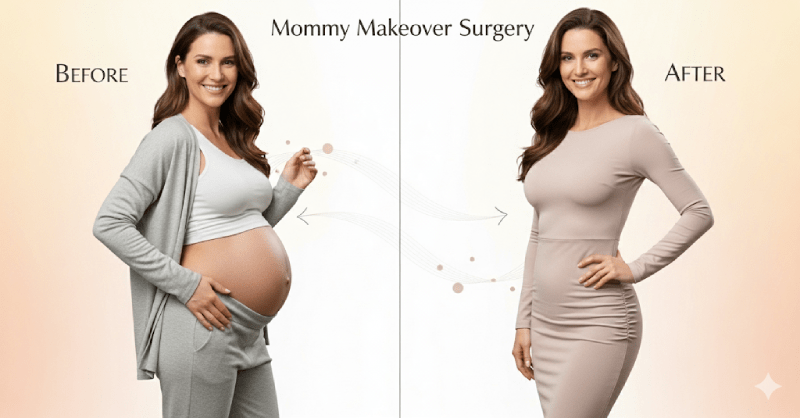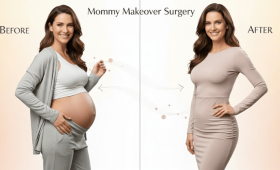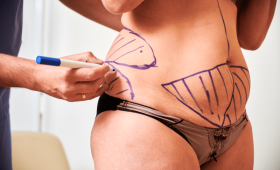Mommy Makeover Evaluation in Türkiye
The decision to undergo a mommy makeover is often a significant and emotionally charged choice, driven by a desire to restore a sense of self and confidence after the transformative experience of childbirth. While the procedure is widely available, an increasing number of individuals are considering medical tourism, with Turkey emerging as a leading destination. This report provides a detailed examination of Turkey’s value proposition for a mommy makeover, analyzing the core appeals of cost and convenience while critically assessing the associated medical, logistical, and legal risks.
The primary allure of Turkey is the profound financial advantage, with costs often being 50-70% lower than in Western countries, including the United States and the United Kingdom. This is frequently coupled with the convenience of “all-inclusive” packages that bundle surgery with essential travel logistics like accommodation and transfers, creating a seamless and attractive patient journey. Furthermore, Turkey’s medical infrastructure is supported by a significant number of internationally accredited hospitals and a legal framework that governs health tourism.
However, this report finds that the benefits are predicated on a critical need for rigorous due diligence. The perceived convenience of all-inclusive packages can mask a deep dependency on the provider and a lack of transparency. Similarly, while institutional accreditations exist, they do not guarantee the competence or ethical conduct of an individual surgeon, placing the onus on the patient to perform independent and meticulous research. The marketing of a mommy makeover as a “health holiday” trivializes the reality of a major surgical procedure, creating unrealistic expectations and potentially encouraging behaviors that can lead to severe complications. Ultimately, the cost savings are real, but they do not account for the catastrophic financial and physical consequences of a botched procedure, for which legal recourse and follow-up care can be exceedingly difficult to obtain. A successful outcome in Turkey requires a patient to move beyond the attractive marketing and engage in a proactive, informed, and realistic approach to their medical journey.
The Mommy Makeover: A Medical & Emotional Journey
1.1 Defining the Mommy Makeover
A mommy makeover is not a single, standardized surgical procedure but a highly personalized suite of cosmetic operations designed to address the physical changes that persist in a woman’s body after pregnancy and childbirth. The specific combination of procedures is tailored to the individual’s unique post-pregnancy concerns and aesthetic goals. The most common components of a mommy makeover traditionally include a tummy tuck (abdominoplasty) and a breast procedure, such as a breast lift (mastopexy) or breast augmentation.
A tummy tuck is performed to correct the lasting effects of pregnancy on the abdomen, which often include diastasis recti—the irreversible stretching of the linea alba, a connective tissue structure that runs through the middle of the abdominal muscles. This condition is responsible for an increased abdominal girth that cannot be corrected through diet or exercise. Additionally, the procedure removes excess, sagging skin and stretch marks, which are tears in the deeper layers of the skin caused by rapid weight fluctuations during pregnancy.
Complementing the abdominoplasty, breast procedures address changes caused by hormonal fluctuations and weight shifts during pregnancy and breastfeeding. A breast augmentation, which involves the insertion of silicone or saline implants, can restore lost volume and enhance breast size and symmetry. Conversely, a breast lift, or mastopexy, is performed to reduce the stretched skin envelope and reposition the nipple and areola to a more aesthetically pleasing, natural location on the chest wall. Other common procedures that may be incorporated into a mommy makeover include liposuction to eliminate stubborn fat deposits and vaginal rejuvenation surgery. These procedures are often combined into a single operation to minimize downtime and provide a comprehensive physical transformation.
1.2 The Underlying Motivations
The physical changes addressed by a mommy makeover are a direct consequence of the physiological demands of pregnancy and motherhood. The expansion of the uterus and the significant weight fluctuations over a short period can lead to permanent changes in the abdominal muscles and skin. The separation of the abdominal muscles, known as diastasis recti, results in a weakened core and a protruding abdomen that resists correction through conventional means like diet and exercise. Similarly, the stretching of the breast skin envelope during lactation and its subsequent deflation can lead to a deflated or sagging appearance. These changes can be particularly distressing for women who were previously active or had a well-defined physique, as they find that their body no longer responds to their efforts in the same way. A tummy tuck directly addresses these issues by removing the excess skin and repairing the underlying musculature, providing a firmer, flatter abdominal profile. The chosen breast procedure helps to restore the pre-pregnancy shape and volume, offering a more youthful contour.

1.3 The Psychological Impact
The decision to undergo a mommy makeover is rarely just about physical aesthetics; it is a deeply personal and emotional journey toward regaining a sense of self. For many women, the physical changes after pregnancy lead to feelings of dissatisfaction and a disconnect with their own body image. Patient testimonials consistently highlight that the procedure is not simply a cosmetic fix but a catalyst for renewed self-confidence and self-esteem. One patient’s story illustrates this, noting that after a “postpartum makeover,” her goal was not just physical change but “reclaiming her self-confidence”. Another account describes the experience as “rediscovering confidence and embracing a new chapter in my life”. These narratives underscore the profound psychological benefits, where the physical transformation positively impacts various aspects of a woman’s life, from personal relationships to social interactions. The procedure allows many to wear clothes they previously felt self-conscious in and to reclaim a sense of body positivity.
The Allure of Turkey: An Economic & Logistical Analysis
2.1 The Economic Imperative: A Comparative Cost Analysis
The most compelling reason for choosing Turkey for a mommy makeover is the substantial cost savings. The price of the procedure in Turkey is significantly lower than in many Western countries, with some packages being up to 50-70% cheaper. This disparity is attributed to a competitive medical tourism market, lower living costs, and reduced operational expenses.
To illustrate this, an analysis of average price ranges reveals a stark contrast. A mommy makeover in Turkey can cost anywhere from $5,000 to $15,000 USD, though prices can be as low as $3,000 to $10,000 depending on the specific procedures and clinic. This is a fraction of the cost in the United Kingdom or the United States. In the UK, a mommy makeover can range from £8,000 to £20,000, while in the US, the average cost can be as high as $24,000 to $40,000 or more, with surgery and aftercare often billed separately. Even considering individual procedures, a tummy tuck in Germany starts at around $5,300, while in Turkey, a full mommy makeover package can begin at $7,476. The following table provides a clear comparison of these costs:
| Country | Average Price Range (USD) | Notes |
| Turkey | $5,000 – $15,000 | Packages often include accommodation, airport transfers, and aftercare |
| UK | $21,000 – $33,000+ | Surgery and aftercare are usually billed separately |
| USA | $24,000 – $40,000+ | Higher surgeon and hospital fees |
This economic incentive is the primary driver of medical tourism to Turkey, allowing individuals with limited financial means to access a procedure that might otherwise be prohibitively expensive.
2.2 The All-Inclusive Package: Convenience as a Selling Point
A key feature of the Turkish medical tourism model is the prevalence of all-inclusive packages. These are designed to provide a seamless, stress-free experience by bundling the medical procedure with all necessary travel logistics. A typical package includes the surgery itself, along with anesthesia, a hospital stay, and all medications administered during hospitalization. Beyond the medical aspects, these packages also cover non-medical services, such as a stay of several nights in a 4- or 5-star hotel, VIP transfers between the airport, hotel, and clinic, and the services of an interpreter to facilitate communication. The inclusion of these services is presented as a way for patients to focus on their recovery while all other arrangements are handled.
2.3 Deeper Insights: The Hidden Psychology of the All-Inclusive Model
The convenience of the all-inclusive package, while a major selling point, creates a profound psychological and logistical dependency on the medical tourism facilitator or clinic. The upfront, bundled price and seamless coordination of travel, accommodation, and medical appointments provide a sense of security that makes the prospect of surgery in a foreign country less intimidating. Patients are drawn in by the promise that “all you have to do is turn up”.
However, this model effectively removes the patient’s need to independently vet and coordinate each step of the journey, which is a critical part of a thorough due diligence process. The patient places their trust entirely in the hands of the agency or clinic, which can create a significant power imbalance. In cases of negative outcomes, this dependency becomes a serious problem. Individuals have reported feeling “ghosted” by their surgeon or clinic after returning home and have described a lack of support when complications arise. The perception of a smooth, all-inclusive process can therefore lull patients into a false sense of security, causing them to bypass essential independent research on the specific surgeon and clinic they are entrusting with their health.
The Promise of Quality: Navigating Medical Standards
3.1 The Importance of Accreditation: JCI and Beyond
Turkey’s medical tourism sector is bolstered by a well-established system of quality control. A significant number of leading hospitals in the country hold global accreditations, with the most respected being the Joint Commission International (JCI). JCI accreditation is a rigorous evaluation process that ensures a hospital meets international standards for patient safety, hygiene, and medical care. This certification is the same one given to top facilities in the United States and Europe, providing patients with a strong sign that the hospital can provide world-class care.
As of recent data, there are more than 50 JCI-certified hospitals across Turkey, located in major cities such as Istanbul, Ankara, and Izmir. Major hospital groups with JCI accreditation include Acıbadem Healthcare Group, Memorial Hospitals, and Anadolu Medical Center, among others. In addition to JCI, the Turkish Ministry of Health acts as the primary regulatory body, licensing medical facilities and practitioners to ensure compliance with national regulations that align with European healthcare standards.
3.2 Vetting Surgeon Credentials and Expertise
While hospital accreditation provides a baseline level of quality assurance, it is equally critical for patients to verify the credentials of their individual surgeon. The Turkish Society of Plastic, Reconstructive and Aesthetic Surgeons is a key professional body, and patients can and should check their website for a list of member surgeons. This provides an objective way to confirm a surgeon’s specialization and licensure, as social media advertising can often be misleading.
Patients are advised to prioritize surgeons who are board-certified and have extensive experience in the specific procedures they are interested in. A detailed consultation, whether in person or remotely, is a crucial opportunity to assess the surgeon’s communication style, track record, and patient outcomes. It is recommended that patients ask about the surgeon’s training, surgical approach, and the specific case volumes related to the procedure they are seeking.
3.3 Deeper Insights: The Credentialing Paradox
The existence of a robust accreditation system and professional societies in Turkey, while a positive indicator, can inadvertently create a false sense of security. The presence of JCI logos and surgeon society memberships provides a veneer of quality that may not always translate to a successful patient outcome, as evidenced by numerous patient complaints and negative experiences. The high volume of patients opting for surgery in Turkey may incentivize some clinics and surgeons to prioritize a high turnover rate over the individualized, meticulous care required for complex procedures.
This creates a paradox where a patient can receive care in an internationally accredited hospital but still be at the mercy of a surgeon who, while credentialed, may lack the ethical standards or personal skill to manage every patient case to a successful conclusion. The reliance on institutional credentials shifts the burden of due diligence onto the patient, who must look beyond logos and actively seek out testimonials, scrutinize before-and-after photos, and conduct a thorough, independent evaluation of the specific surgeon they are considering. The difficulty of this task from abroad underscores the inherent risks of medical tourism.

The Patient Experience: A Realistic Recovery Roadmap
4.1 The Pre-operative Phase: Remote Consultations and Preparation
The patient journey for a mommy makeover in Turkey typically begins with remote consultations, often conducted via platforms like WhatsApp, where patients send photos and communicate their goals with a patient coordinator. While convenient, this practice can lead to a rushed decision-making process. The lack of an in-person consultation and a “cooling off period” of several weeks—which is standard in many countries—means patients may not have enough time to fully consider the procedure, its risks, and its alternatives before traveling.
4.2 The On-Site Experience: From Arrival to Discharge
Upon arrival in Turkey, patients are typically greeted by a VIP transfer service that takes them directly to their hotel or the clinic. The pre-operative phase involves a final consultation with the surgeon, blood tests, and other necessary health checks before the surgery is performed. After the operation, patients are moved to a recovery room for close supervision, and most are advised to stay in the hospital for 1-2 nights for post-operative monitoring.
4.3 The Recovery Roadmap: Fantasy vs. Reality
The marketing of a mommy makeover in Turkey as a “health holiday” often creates unrealistic expectations that diverge sharply from the medical reality of recovery. The journey is a gradual process that requires significant rest and adherence to a strict post-operative plan, not sightseeing and sunbathing, which are strongly discouraged due to the risk of complications.
A realistic recovery timeline is as follows:
- Immediate Recovery (First 72 hours): Patients can expect to experience moderate pain, swelling, bruising, and tightness, which are managed with prescribed analgesia. Drainage tubes are common after a tummy tuck to remove excess fluid, and compression garments must be worn to assist in the healing process and reduce swelling. Movement is limited, and patients are advised to rest to allow their bodies to begin the healing process.
- Weeks 1-4: The first week is critical for healing. Patients must continue wearing compression garments and moving gently to prevent blood clots, avoiding any heavy lifting, bending, or strenuous activities. By the second or third week, swelling and bruising begin to subside, and light activities can be resumed. Patients may have their drains removed during this time and have a follow-up visit with their surgeon before flying home.
- Months 2 and Beyond: Most of the swelling has subsided, and the body begins to settle into its final shape. Patients can gradually return to normal activities, including light exercise, with their surgeon’s approval. Full recovery and the final results, however, may not be visible for 6-12 months.
4.4 Deeper Insights: The Dangers of Trivializing a Major Procedure
The marketing that frames a mommy makeover as a “health holiday” or an opportunity to “see the wonders of Istanbul as you heal” is not merely an irresponsible sales tactic; it poses a significant public health risk. This messaging trivializes a major surgical procedure, creating unrealistic patient expectations and potentially encouraging behaviors that could lead to severe complications. Patients, believing they are on vacation, may engage in activities like sunbathing, swimming, or excessive walking, which medical professionals explicitly warn against, as they can increase the risk of infection and blood clots (DVT).
When the reality of a difficult and painful recovery sets in, it can lead to significant psychological distress and emotional regret, as the promised experience does not align with the physical reality. A mother from the UK recounted her experience of a botched surgery, stating, “They told me I’d be sitting by the pool within three days. I was rotting in a hotel room”. The disconnect between the advertised fantasy and the actual medical journey can be emotionally devastating and underscores the critical need for patients to be informed by medical facts rather than marketing brochures.
A Critical Assessment of Risks: The Hidden Costs of Medical Tourism
5.1 Medical and Surgical Risks
While Turkey boasts state-of-the-art facilities and experienced surgeons, a mommy makeover, like any major surgery, carries inherent risks. Common complications include hematoma, blood clots, and infection. The combination of multiple procedures, such as a tummy tuck and liposuction, can increase the risk of major complications from 1.4% to 4%. A particularly life-threatening risk for medical tourists is deep vein thrombosis (DVT) or a blood clot, which is heightened by long-distance air travel in close proximity to major surgery. The NHS advises against flying for at least 7-10 days after a tummy tuck to mitigate this risk.
One patient’s harrowing account from a botched surgery highlights the worst-case scenario: a woman was left with a severe infection, dead tissue, and had to undergo a second procedure without general anesthesia, during which she could hear the “sizzling” of her skin as it was worked on. Her recovery required multiple corrective surgeries and left her with chronic pain and significant scarring, demonstrating the profound physical dangers when things go wrong.
5.2 Aftercare and Follow-up Challenges
A major and often unaddressed pitfall of medical tourism is the challenge of aftercare and follow-up. When a patient returns home, they may not have access to the same comprehensive medical professionals who provided their initial care. The NHS advises patients to clarify what happens if complications arise and where follow-up appointments will be held. Many domestic surgeons are reluctant to treat complications from overseas procedures, which can leave the patient with no professional help. In such cases, patients may find themselves in an emergency room or facing the added financial burden of paying for corrective surgery and extended care that was not part of the initial “all-inclusive” package. The lack of a direct contact person for aftercare after returning home can create a critical gap in medical support.
5.3 Legal and Ethical Considerations
The legal barriers to seeking recourse for a botched surgery abroad are significant. It is exceedingly difficult for a patient to sue a foreign surgeon in their home country, as the legal case would typically need to be filed where the injury occurred. This requires the plaintiff to navigate a foreign legal system that may not offer the same patient protections or compensation as their home country. For a US plaintiff, a court would likely apply the law of the destination country, which may have limited awards for medical malpractice. Furthermore, there are reports of surgeons “disappearing” or being unwilling to fix their mistakes, making it difficult to even begin legal proceedings. The UK’s Advertising Regulator, the ASA, has also issued an enforcement notice specifically targeting foreign medical tourism providers, many of them Turkish, for misstating the fundamentals of their proposition, trivializing the risks, and using socially irresponsible marketing.
5.4 Deeper Insights: The True Cost of a Botched Surgery
The financial savings of a mommy makeover in Turkey are potentially a mirage, as they do not account for the catastrophic financial, physical, and emotional costs of a complication that must be handled without legal or professional recourse. The initial price tag is a quote for a successful outcome, not a contingency plan for a negative one. If a complication arises, the patient faces new and potentially exorbitant costs, including emergency room visits, corrective surgeries (which local surgeons may not want to perform), and a complete loss of any initial savings.
The financial burden can be compounded by the physical and psychological toll of a “botched” procedure, which can lead to extended time off work and severe emotional distress. A patient who had a difficult experience described how she was “sold a dream” but faced “problems of problems” with no support, ultimately spending close to 20,000 euros for corrective surgeries. The decision to choose Turkey is, therefore, a choice to assume a significant, unquantifiable risk that is not reflected in the initial price. The report’s role is to make this hidden cost transparent, underscoring that a successful outcome is a gamble that can yield significant savings but also lead to financial and physical ruin.
A Due Diligence Checklist for a Safe Mommy Makeover
6.1 Vetting Your Surgeon and Clinic
To mitigate the risks associated with a mommy makeover in Turkey, a patient must engage in a rigorous and proactive due diligence process. The first step is to vet the surgeon and clinic with meticulous care. It is crucial to look for reputable sources and to go beyond marketing on social media. Patients should confirm that the hospital is JCI-accredited and that the surgeon is a member of the Turkish Society of Plastic, Reconstructive and Aesthetic Surgeons. Asking to see a surgeon’s before-and-after photos and requesting to speak with former patients with similar procedures is invaluable. Trusting one’s instincts during the consultation and feeling comfortable with the surgeon’s communication style are also important indicators of a positive experience.
6.2 Questions to Ask Your Surgeon and Facilitator
A patient should come prepared with a comprehensive list of questions for their surgeon and the medical tourism facilitator. These questions should focus on transparency and contingency planning, covering topics that marketing materials often omit.
- “What is your specific experience with this exact combination of procedures?”
- “What are the most common complications you have experienced with this procedure, and how were they handled?”
- “What are the specific contingency plans for complications while I am in Turkey and after I return home?”
- “Who will provide my follow-up care when I return home, and how will I be able to contact you or a member of your team?”
- “What is included in the package price, and what expenses are not covered?”
- “Can you provide the name and contact information of a former patient with a similar procedure?”
6.3 Scrutinizing the Package and Contract
Before signing any contract, a patient should carefully scrutinize the “all-inclusive” package to ensure every service is itemized and that there are no hidden fees. This includes clarifying the specifics of the hospital stay, hotel accommodation (number of nights, star rating), and transportation services. It is also critical to understand the legal terms of the agreement and what recourse is available in the event of a complication. The following checklist provides a summary of essential due diligence steps:
Table 1: The Ultimate Due Diligence Checklist
| Category | Actionable Items |
| Surgeon & Clinic | Verify JCI accreditation of the hospital. |
| Check for surgeon’s membership in the Turkish Society of Plastic, Reconstructive and Aesthetic Surgeons. | |
| Review a minimum of three before-and-after portfolios for similar procedures. | |
| Consultation | Conduct a detailed, pre-travel consultation with the specific surgeon. |
| Ask for a full list of potential risks and complications. | |
| Logistics & Recovery | Obtain a clear, written recovery plan with timelines for returning to activities. |
| Confirm aftercare and follow-up protocols for after returning home. | |
| Plan to wait the recommended 7-10 days before flying after a tummy tuck. | |
| Financial & Legal | Scrutinize the contract for all itemized costs and potential hidden fees. |
| Research the legal recourse options in Turkey in case of complications. | |
| Confirm what insurance, if any, the clinic or surgeon has and what it covers. |
Conclusion: Weighing the Trade-Offs
Turkey has cemented its reputation as a global leader in medical tourism for good reason. The allure is multifaceted, driven by significant cost advantages, a sophisticated medical infrastructure with JCI-accredited hospitals, and the convenience of all-inclusive packages that streamline the entire patient journey. For many, a mommy makeover in Turkey can be a safe, life-changing experience that would otherwise be financially out of reach.
However, the analysis in this report makes it clear that this path is not without substantial risk. The inherent danger lies in a patient’s potential to be seduced by the cost savings and the promise of a “health holiday,” thereby overlooking the critical due diligence required for a major surgical procedure. The very convenience that makes Turkey so appealing—the all-inclusive model—can create a profound dependency that leaves a patient vulnerable if complications arise. Furthermore, the legal and logistical barriers to seeking recourse or aftercare from abroad are significant and can turn an initial financial saving into a catastrophic loss.
A successful mommy makeover in Turkey is not a matter of chance; it is a direct result of a patient’s commitment to rigorous, independent research and a realistic understanding of the medical journey. The ultimate message is one of empowerment through information: choose Turkey for a mommy makeover, but do so with your eyes wide open, fully aware of the trade-offs and prepared to proactively manage every step of the process. The true measure of a successful experience lies not in the initial price tag, but in a safe, healthy, and satisfying outcome, wherever in the world that may be.



